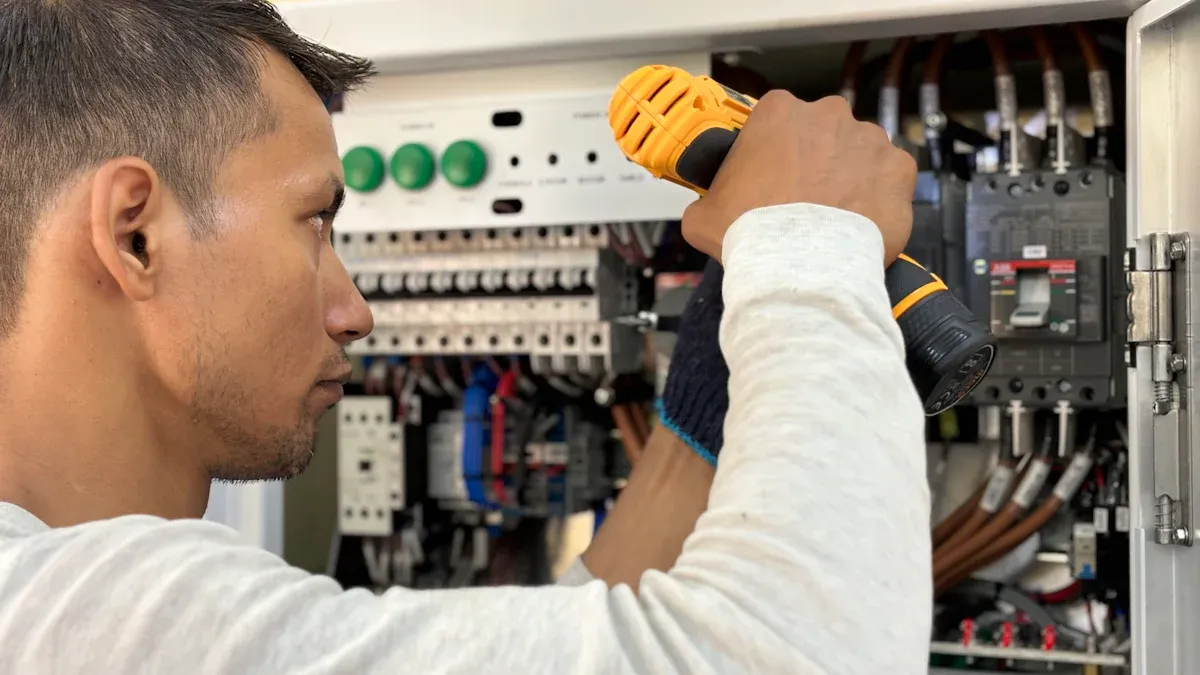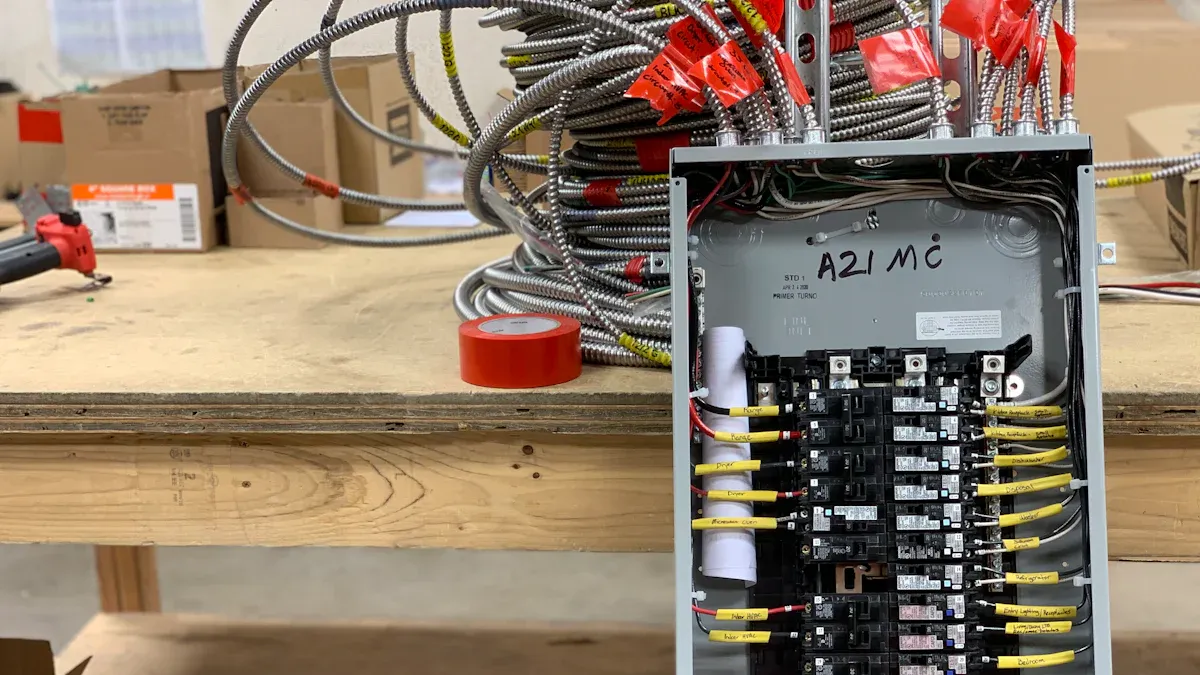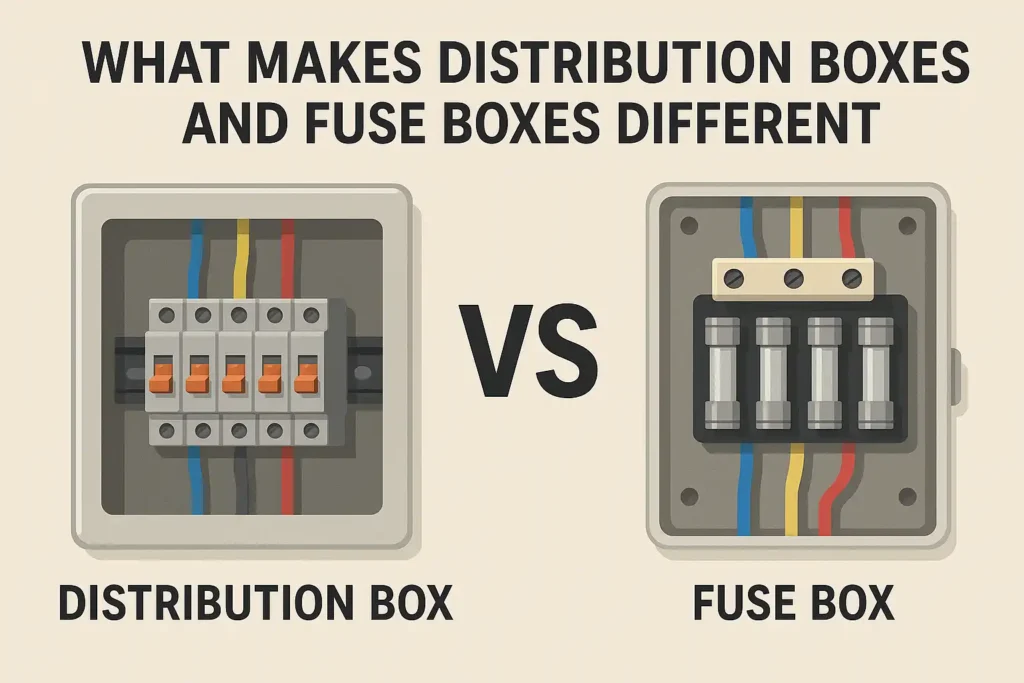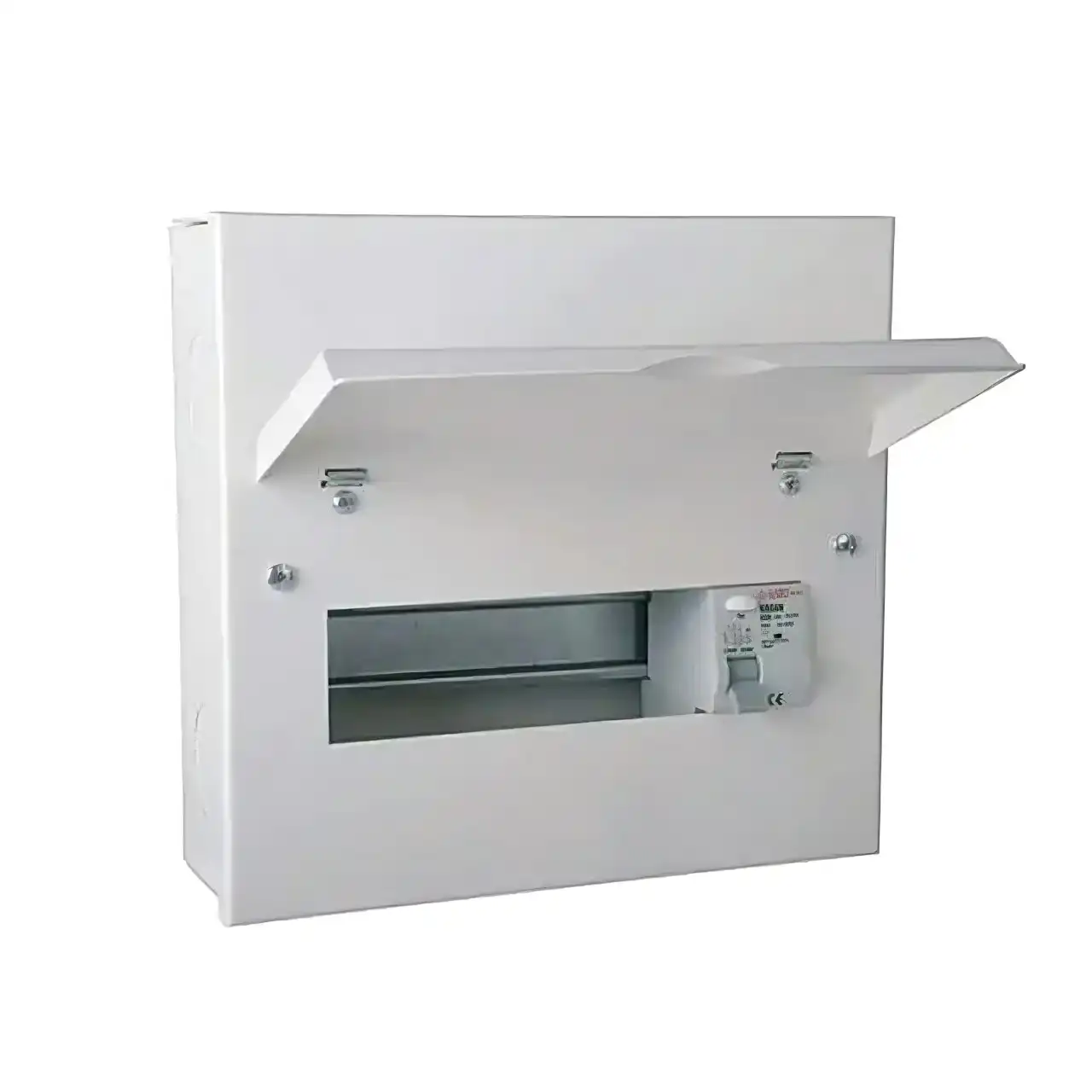You may ask what makes a distribution box and fuse box different. The main difference is in what they do. A distribution box sends electrical power to many circuits. A fuse box keeps each circuit safe by stopping power if there is a problem. Some people use these words for the same thing, but they do not always mean the same job.
Key Takeaways
- Distribution boxes give power to many circuits. Fuse boxes keep circuits safe by cutting power if there is a problem. – Pick the right box for what you need. Use a distribution box to manage power. Use a fuse box to protect circuits. – Always choose boxes that follow local safety rules. Make sure they protect well against dust and water. – Check your electrical boxes once a year. Replace any broken parts to keep things safe. – If you are not sure about installing or upgrading, ask a licensed electrician for help.
Definitions
Distribution Box
A distribution box helps keep electrical wires neat and safe in one spot. You see these boxes in houses, offices, or outside where power needs to be split up. Distribution boxes come in different sizes. Some are small and easy to move. Others are bigger and stay on a wall. They can be made from plastic, metal, or polycarbonate. The material depends on where you use the box.
Here is a table to help you see the main features:
| Feature | Distribution Box |
|---|---|
| Function | Keeps local electrical connections neat and safe |
| Size & Design | Small, easy to move, or fixed to a wall |
| Installation Location | Inside or outside |
| Material Composition | Plastic, polycarbonate, or metal |
| Safety Features | Seals to keep out dust and water |
| Maintenance | Needs to be checked sometimes |
| Cost | Not expensive, simple box |
| Lifespan | Depends on where and how you use it |
| Regulatory Compliance | Follows local safety rules |
Distribution boxes are good for short-term setups, building sites, or outdoor parties. You can trust them to give safe power in small places.
Fuse Box
A fuse box keeps your wires safe by stopping power if there is a problem. You find fuse boxes in homes, cars, and machines. Each fuse has a voltage and current number. If too much power goes through, the fuse breaks and stops the power. This keeps things from getting damaged or starting a fire.
Fuse boxes must follow strict safety rules like IEC and UL. The box and fuses have numbers for voltage, current, and how much they can break. These numbers make sure the fuse box works safely. Heat and wetness can change how well a fuse works. You should check the box and change fuses when needed.
Tip: Always pick the right fuse type and number for your fuse box. This keeps everything safe and working right.
Overlapping Terms
Sometimes people call a distribution box and a fuse box the same thing. This is because both boxes help control and protect wires. But their main jobs are not the same. A distribution box splits and organizes power. A fuse box protects circuits. Sometimes, both jobs are in one box, especially in old houses or cars. Knowing the difference helps you pick the right box for your job.
Features and Applications

Key Features
Modern distribution boxes have many helpful features. They come in many shapes, sizes, and materials. Some are small and work with one circuit only. Others can handle more than twelve circuits at the same time. You can put them on walls, floors, or inside walls to look neat. The market for these boxes is getting bigger every year. In 2024, it was worth $2.5 billion. By 2033, it could reach $4.8 billion. The market grows about 7.8% each year.
Here is a table with some key facts:
| Feature Category | Details / Numerical Data |
|---|---|
| Market Size (2024) | USD 2.5 billion |
| Market Size (2033 forecast) | USD 4.8 billion |
| CAGR (2026-2033) | 7.8% |
| Types | Power, Consumer, Lighting, Data |
| Applications | Industrial, Commercial, Residential, Utilities |
| Mounting Types | Wall, Floor, Flush, Surface |
| Number of Circuits | Single, Multi (2-12), High Capacity (>12) |
| Key Countries | U.S., Canada, Germany, China, India, Brazil, UAE |
Typical Uses
Distribution boxes are used in many places. In homes, they send power to each room and help smart devices work. Builders like plastic boxes because they are cheap and can handle bad weather. Offices, factories, and hospitals often use boxes on the wall so people can reach them easily. Boxes inside walls look nice in fancy homes or offices.
| Installation Type | Typical Uses | Key Characteristics | Supporting Factors |
|---|---|---|---|
| Residential | Power for homes, apartments, smart tech | Plastic boxes, weatherproof, cost-effective | Urban growth, new tech, better living standards |
| Commercial | Power for offices, factories, data centers | Surface or flush mount, easy access, smart systems | Safety, looks, high data needs |
Note: Big data centers use rack-mount fiber optic distribution boxes. These boxes help control lots of data and make upgrades simple. You find them where fast and safe data is important.
Safety Aspects
Safety is very important when picking a distribution box or fuse box. You need to choose the right size and type for your job. Always make sure the box meets local safety rules. Good boxes keep out dust and water. They also stop wires from getting too hot or starting fires. Check your box often and change any broken parts. If you are not sure what to do, ask a licensed electrician for help.
Distribution Box and Fuse Box Comparison

Function
You need to know what each box does before you choose one. A distribution box sends power from one main source to many smaller circuits. You use it to organize and control where electricity goes in a building or area. A fuse box protects each circuit by stopping the flow of electricity if something goes wrong, like a short circuit or overload. This keeps your home or equipment safe from fires or damage.
Tip: If you want to split power to many places, pick a distribution box. If you want to protect each circuit, use a fuse box.
Design
The design of a distribution box and fuse box looks different because they do different jobs. A distribution box often has many terminals or connectors inside. You can find them in plastic, metal, or polycarbonate. They may have seals to keep out dust and water. A fuse box has slots for fuses or circuit breakers. You can open the cover to check or replace a fuse. Some fuse boxes have clear windows so you can see if a fuse is blown.
- Distribution boxes focus on neat wiring and easy access for adding or removing circuits.
- Fuse boxes focus on safety and quick fuse replacement.
Installation
You install a distribution box in places where you need to split power, like in a new room, garage, or outdoor event. You can mount it on a wall, inside a wall, or even on a pole outside. The process is simple if you follow the instructions and local codes.
You install a fuse box where you need to protect circuits, like in your home, car, or machine. You must match the fuse size and type to the circuit. If you install the wrong fuse, it may not protect you from danger.
Note: Always turn off the main power before you install or work on any electrical box. If you feel unsure, call a licensed electrician.
Cost
The cost of a distribution box and fuse box depends on size, material, and features. Distribution boxes are usually less expensive because they are simple and do not have moving parts. You can find small plastic ones for a low price. Larger metal boxes cost more.
Fuse boxes cost more because they include fuses or breakers. You may need to buy extra fuses for backup. Some modern fuse boxes have smart features, which can raise the price.
| Feature | Distribution Box | Fuse Box |
|---|---|---|
| Main Purpose | Splits and organizes power | Protects circuits from overload |
| Design | Many terminals, neat wiring | Fuse slots, safety covers |
| Installation | Wall, floor, outdoor, indoor | Home, car, machine, easy access |
| Cost | Usually lower, simple build | Higher, includes fuses/breakers |
| Safety Role | Keeps wiring safe and tidy | Stops power in unsafe conditions |
Remember: The terms distribution box and fuse box sometimes overlap. Some boxes do both jobs, especially in older homes or vehicles. You should always check what features you need before you buy.
Choosing the Right Box
Assessing Needs
You need to start by thinking about your specific electrical needs. Look at the number of circuits you want to manage and the total power your system will use. Check if you need to split power to different rooms or protect each circuit from overload. This step helps you decide if you need a distribution box, a fuse box, or a combination of both.
Use the table below to guide your choice:
| Aspect | Details |
|---|---|
| Safety Features | Circuit breakers or fuses protect against overload and short circuits. |
| Material & Durability | Steel or strong plastic resists damage and weather. |
| Compliance & Certifications | Look for UL, CE, ISO, or other safety marks. |
| Numerical Safety Ratings | IP ratings show water and dust protection (IP20 to IP69). |
| Size & Capacity | Match the box size to your electrical load and number of circuits. |
| Installation Location | Avoid wet, hot, or dusty places for better safety. |
| Inspection Frequency | Check your box every year or after big electrical problems. |
Tip: Always check the IP rating. For example, IP20 gives basic protection, while IP65 or higher works better outdoors or in dusty places.
Home vs. Vehicle Use
You will find that the needs for a home are different from those for a vehicle. In a home, you often need to manage many circuits for lights, outlets, and appliances. You may want a distribution box and fuse box together for better control and safety. In a car or RV, you usually have fewer circuits, but you need strong protection from bumps, heat, and moisture.
- Home Use: Choose a box with enough space for all your circuits. Make sure it meets local codes and has a good IP rating for your environment. Look for boxes with clear labels and easy access for maintenance.
- Vehicle Use: Pick a compact, sturdy box that can handle vibration and temperature changes. Make sure the box is sealed against dust and water. Use the right size fuses for each circuit to prevent damage.
Note: Always match the box to your environment. A box that works well in a dry basement may not last in a damp garage or a moving vehicle.
When to Upgrade
You should know when it is time to upgrade your electrical box. Watch for these signs:
- Circuit breakers trip often.
- Lights flicker or dim.
- You smell burning or see scorch marks.
- You use many extension cords or power strips.
- Your panel is older than 30 years or does not meet modern safety codes.
Experts recommend upgrading your system every 15 to 20 years or sooner if you notice problems. Older boxes may not handle new appliances or smart devices. Upgrading to a 200-amp panel or a smart panel gives you more power and better safety. The process starts with a professional assessment, load calculations, and checking local codes. You need permits and inspections to make sure everything is safe.
- Upgrades improve safety and lower the risk of fire.
- New boxes help you save energy and add smart features.
- A modern system increases your home’s value and future-proofs your setup.
⚡ Always hire a licensed electrician for upgrades or new installations. Professionals know how to follow safety rules and can spot hidden problems. They also provide warranties for their work.
Choosing between a distribution box and fuse box depends on your needs, safety, and environment. Take time to assess your setup, look for warning signs, and do not hesitate to call an expert if you feel unsure.
You now know the main differences between a distribution box and a fuse box. A distribution box sends power to different circuits. A fuse box protects each circuit from danger. You should always check your needs before you choose. Safety comes first. If you feel unsure, ask a licensed electrician for help. Careful planning keeps your home or vehicle safe and your power running smoothly.
FAQ
What is the main job of a distribution box?
A distribution box sends power from one main source to different circuits. You use it to organize and manage where electricity goes in your home or building.
Can a fuse box and distribution box be the same thing?
Sometimes, you find both in one box, especially in older homes or vehicles. You should check the features before you buy. Each box has a main job, but some boxes do both.
How often should you check your fuse box or distribution box?
You should check your box at least once a year. Look for signs of damage, loose wires, or burned marks. If you see problems, call a licensed electrician.
What happens if you use the wrong fuse in a fuse box?
Using the wrong fuse can cause overheating or fire. Always match the fuse size to your circuit. If you feel unsure, ask an expert for help.
The following information may be of interest to you
What Is a Fused Distribution Box and How Does It Work
What is the Function of a Distribution Box in Electrical Systems
Can I replace a fuse with a circuit breaker?
What is the difference between a circuit breaker and a fuse?




